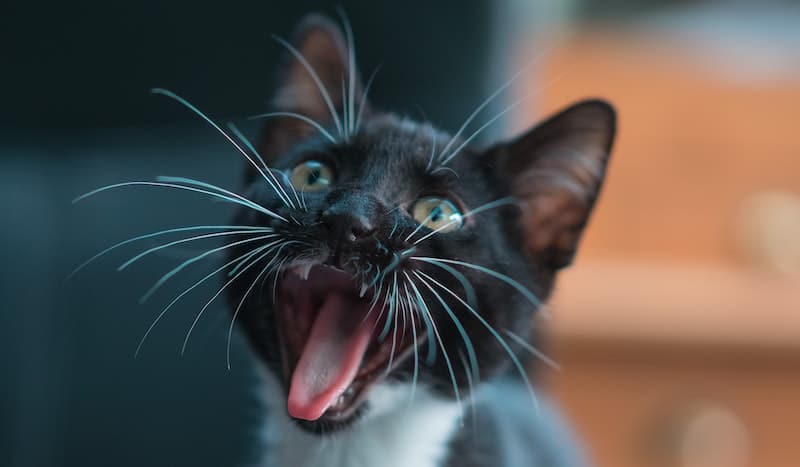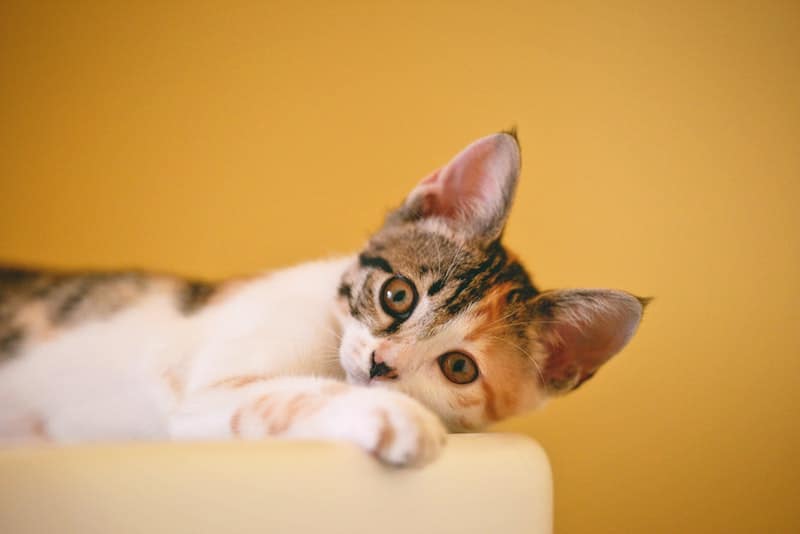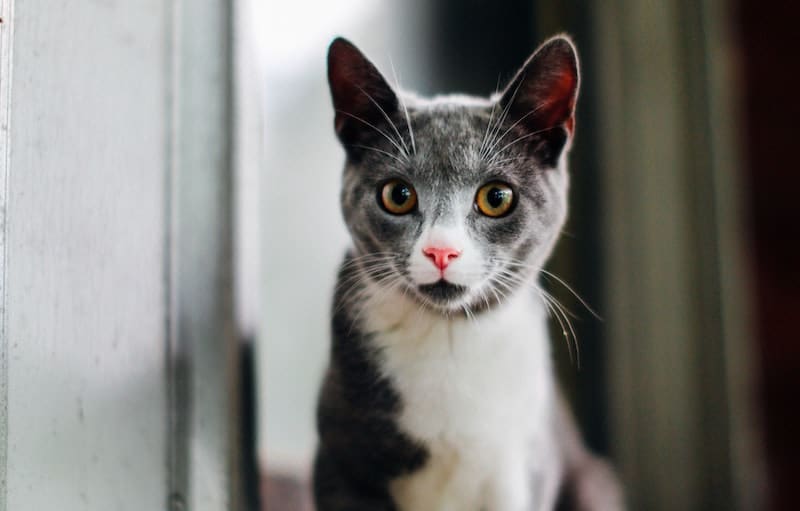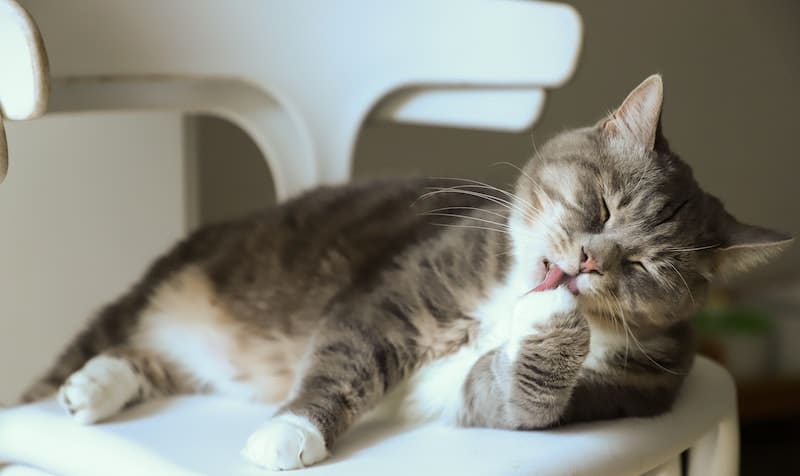Cats are known for their independent nature and impeccable grooming habits. They are known to be clean and fastidious animals, but even the most diligent feline can suffer from bad breath, also known as halitosis. There can be many different answers to the question “why does my cat’s breath smell?”, including dental disease, kidney disease and diabetes.
Clearly bad breath in your cat an be unpleasant to deal with, but it can also be a sign of a concerning health problem. We’ll discuss the 8 most common reasons for bad breath in cat, and what you can do about it.
Table of Contents
- 1. Dental Problems
- 2. Kidney Disease
- 3. Liver Disease
- 4. Diabetes
- 5. Respiratory Infections
- 6. Gastrointestinal Problems
- 7. Oral Tumors
- 8. Foreign Objects
- FAQs: Why Does My Cat’s Breath Smell?
1. Dental Problems

Dental problems are the most common cause of bad breath in cats. If your cat’s breath smells like rotten eggs or has a foul odor, it may be due to dental issues such as tartar buildup, gingivitis, or periodontal disease.
If left untreated, dental issues can lead to more serious health problems. The good news is that dental problems can be diagnosed and treated with proper care and attention.
Diagnosis of dental problems in cats usually starts with a physical examination by a veterinarian. During the exam, the vet will check your cat’s teeth, gums, and mouth for any signs of decay, inflammation, or infection. They may also perform a dental x-ray to check for any hidden dental issues.
If your cat is diagnosed with a dental problem, the treatment will depend on the severity of the issue. In mild cases, the vet may recommend a professional dental cleaning under anesthesia to remove any tartar or plaque buildup on the teeth. In more severe cases, extractions or other dental procedures may be necessary.
In addition to professional dental care, there are steps you can take at home to help prevent dental problems in your cat. Regular brushing of your cat’s teeth with a cat-specific toothpaste can help remove plaque and prevent tartar buildup. Dental chews and toys can also help keep your cat’s teeth clean and healthy.
Common dental diseases in cats:
- Periodontal disease: This is the most common dental disease in cats. It is caused by the buildup of plaque and tartar on the teeth, which can lead to gum inflammation and tooth decay. If left untreated, it can lead to tooth loss and other health problems.
- Tooth resorption: Tooth resorption is a painful dental condition where the tooth’s structure is broken down by the body. The tooth eventually disintegrates, causing pain and discomfort. This condition can be difficult to detect, but early detection is crucial for proper treatment.
- Gingivitis: Gingivitis is a mild form of periodontal disease that affects the gums. It is characterized by red, inflamed gums that bleed easily. If left untreated, it can lead to more serious dental problems.
- Feline odontoclastic resorptive lesions (FORL): FORLs are a type of tooth resorption that affects up to 70% of cats over the age of five. They cause painful lesions in the teeth, which can lead to difficulty eating and other health problems.
- Feline stomatitis: This is a severe form of gingivitis that affects the entire mouth. It is characterized by painful, inflamed gums, and can lead to tooth loss and other health problems if left untreated.
2. Kidney Disease
Kidney disease is another common cause of bad breath in cats. When the kidneys are not functioning properly, toxins can build up in the bloodstream and cause a foul odor in the cat’s breath.
if you suspect your cat might have kidney disease, it’s vital to get them to a vet as soon as possible to begin testing and treatment. Here are a few other signs of kidney disease in cats to help you determine if you need to take this next step:
- Increased thirst and urination
- Loss of appetite
- Weight loss
- Vomiting and diarrhea
- Dehydration
- Bad breath
- Lethargy and weakness
- Poor coat condition
- Ulcers in the mouth
- Increased frequency of urinary tract infections.
Luckily, there have been a lot of advancements made in diagnosing and treating kidney disease in cats over the years. Your vet will take some or all of the following diagnostic tests to confirm whether your cat has kidney disease:
- Blood tests: Blood tests can help diagnose kidney disease by measuring the levels of waste products in the blood, such as creatinine and blood urea nitrogen (BUN).
- Urine tests: Urine tests can help identify the presence of protein or blood in the urine, which can be an early sign of kidney disease.
- Imaging tests: Imaging tests such as X-rays or ultrasound can help identify any abnormalities in the kidneys or urinary tract.
Treatment for kidney disease will vary based on the type and stage:
- Diet: A special diet can help manage kidney disease in cats. The diet should be low in protein, phosphorus, and sodium, and may also include supplements such as omega-3 fatty acids to help maintain kidney function.
- Fluid therapy: Cats with kidney disease often become dehydrated, so fluid therapy may be necessary to maintain hydration levels and prevent further damage to the kidneys.
- Medications: Medications such as phosphorus binders or ACE inhibitors may be prescribed to help manage the progression of kidney disease.
And as a final note, your best bet in defeating kidney disease is preventing it from happening in the first place. While not all cases of kidney disease in cats are preventable, here are a few ways you can give your cat the best chance of success:
- Hydration: Encouraging your cat to drink plenty of water can help prevent kidney disease.
- Regular check-ups: Regular check-ups with a veterinarian (recommended at least once per year) can help detect kidney disease early, when treatment is most effective.
- Avoiding toxins: Avoiding exposure to toxins such as certain plants and cleaning products can help prevent kidney disease.
3. Liver Disease

Liver disease can also cause bad breath in cats. When the liver is not functioning properly, it can lead to a buildup of toxins in the bloodstream, which can cause a foul odor in the cat’s breath.
If you suspect your cat might have liver disease, take them to a vet right away. Here are some symptoms of liver disease in cats:
- Loss of appetite
- Weight loss
- Vomiting and diarrhea
- Lethargy and weakness
- Yellowing of the skin and eyes (jaundice)
- Increased thirst and urination
- Blood clotting disorders
- Swollen abdomen
- Behavioral changes
- Neurological symptoms such as seizures or disorientation.
Your vet will be able to determine if your cat has liver disease with the following diagnostic tests:
- Blood tests: Blood tests can help diagnose liver disease by measuring the levels of liver enzymes and other markers in the blood.
- Imaging tests: Imaging tests such as X-rays or ultrasound can help identify any abnormalities in the liver or surrounding organs.
- Biopsy: In some cases, a biopsy of the liver may be necessary to diagnose liver disease.
Fortunately there are treatments for cat liver disease, although they have varying degrees of success:
- Medications: Medications such as antibiotics or anti-inflammatory drugs may be prescribed to treat infections or reduce inflammation in the liver.
- Dietary changes: A special diet may be recommended to help manage liver disease in cats. The diet should be low in protein, phosphorus, and sodium, and may also include supplements such as antioxidants to help support liver function.
- Fluid therapy: Cats with liver disease often become dehydrated, so fluid therapy may be necessary to maintain hydration levels and support liver function.
- Surgery: In some cases, surgery may be necessary to remove tumors or cysts from the liver.
And as with anything else, preventing cat liver disease in the first place is the best measure. Here are a few things you can do reduce your cats risk of liver disease:
- Avoiding toxins: Avoiding exposure to toxins such as certain plants and cleaning products can help prevent liver disease.
- Vaccinations: Vaccinations can help prevent infectious diseases that can cause liver damage.
- Regular check-ups: Regular check-ups with a veterinarian (at least once per year) can help detect liver disease early, when treatment is most effective.
4. Diabetes
Diabetes can also cause bad breath in cats. When a cat has diabetes, their body is not able to properly regulate blood sugar levels, which can lead to a buildup of ketones in the bloodstream. This can cause a sweet or fruity odor in the cat’s breath.
If left untreated, diabetes can cause serious health problems such as kidney damage, nerve damage, and even blindness. If your cat has several of the following symptoms of feline diabetes, take them to the vet right away:
- Increased thirst and urination
- Weight loss despite increased appetite
- Lethargy and weakness
- Poor coat condition
- Increased appetite
- Dehydration
- Vomiting and diarrhea
- Urinary tract infections
- Changes in behavior, such as decreased activity or increased irritability
- Breathing difficulties
Here are some steps for diagnosing and treating diabetes in cats:
- Blood tests: Blood tests can help diagnose diabetes by measuring the levels of glucose (sugar) in the blood.
- Urinalysis: A urinalysis can also help diagnose diabetes by measuring the levels of glucose in the urine.
- Physical exam: A physical exam can help identify any symptoms of diabetes, such as weight loss, increased thirst and urination, and lethargy.
Treatment of feline diabetes can be quite successful. Here are some common treatment options:
- Insulin injections: Most cats with diabetes require daily insulin injections to help regulate their blood sugar levels. Your veterinarian can show you how to administer insulin injections at home.
- Dietary changes: A special diet may be recommended to help manage diabetes in cats. The diet should be low in carbohydrates and high in protein and fiber, and may also include supplements such as antioxidants to help support overall health.
- Monitoring: Regular monitoring of your cat’s blood sugar levels is important for ensuring that their diabetes is well-controlled. Your veterinarian may recommend periodic blood tests or glucose monitoring at home.
- Exercise: Regular exercise can help improve insulin sensitivity and promote overall health in cats with diabetes.
Keeping your cat at a healthy weight is the best way to prevent diabetes in your cat. We’ve created a feeding calculator to help your determine exactly how much dry or wet food to give your cat each day.
We’ve also put together some helpful recommendations on how to help your cat lose weight.
5. Respiratory Infections

Respiratory infections such as bronchitis or pneumonia can also cause bad breath in cats. These infections can cause inflammation and infection in the cat’s respiratory system, which can lead to a foul odor in the cat’s breath.
Cat respiratory infections are common and can be caused by a variety of factors, including viruses, bacteria, and allergens. If left untreated, respiratory infections can lead to more serious health problems such as pneumonia.
Some cat respiratory infections will heal and go away on their own. It’s important to monitor your cat’s symptoms to see if they don’t go away or worsen with time. Here are some common symptoms of cat respiratory infections:
- Sneezing
- Coughing
- Nasal discharge
- Runny eyes
- Eye discharge
- Fever
- Loss of appetite
- Lethargy
- Rapid breathing or shortness of breath
- Wheezing
- Open-mouth breathing
- Dehydration
- Blue-tinged gums or tongue
Your vet will be able to pinpoint the exact cause of your cat’s respiratory infection with a swab or blood test. Depending on the diagnosis, treatment options will include:
- Antibiotics: Antibiotics may be prescribed to treat bacterial respiratory infections in cats.
- Antiviral medications: Antiviral medications may be prescribed to treat viral respiratory infections in cats.
- Anti-inflammatory drugs: Anti-inflammatory drugs such as corticosteroids may be prescribed to reduce inflammation in the airways.
- Nebulizer therapy: Nebulizer therapy involves administering medications through a nebulizer machine, which can help deliver medication directly to the lungs.
- Fluid therapy: Fluid therapy may be necessary to help prevent dehydration and support overall health.
- Nutritional support: Nutritional support may be necessary for cats who are not eating due to respiratory infection.
The two most common ways of preventing respiratory infections in cats are to make sure they are up to date on their vaccinations (to prevent viruses) and reduce your cat’s exposure to allergens such as dust and cigarette smoke.
6. Gastrointestinal Problems
Gastrointestinal problems such as constipation or diarrhea can also cause bad breath in cats. These conditions can cause an imbalance of bacteria in the cat’s digestive system, which can lead to foul breath that will have you wondering “Why does my cat’s breath smell?”.
Cats are known for their sensitive digestive systems, and gastrointestinal problems are a common issue in felines. These problems can range from mild to severe, and may be caused by a variety of factors such as infections, food intolerance, or underlying health conditions. Here are some types of gastrointestinal problems in cats and how they can be treated.
- Vomiting and diarrhea are common gastrointestinal problems in cats. They may be caused by various factors, such as dietary indiscretion, ingestion of a foreign object, or an underlying health condition. Treatment may include fasting for 12-24 hours, providing small amounts of water frequently, and gradually introducing a bland diet such as boiled chicken and rice. If symptoms persist or worsen, a visit to the veterinarian may be necessary.
- Inflammatory bowel disease (IBD) is a chronic condition that causes inflammation of the gastrointestinal tract. It can cause symptoms such as vomiting, diarrhea, weight loss, and abdominal pain. Treatment may involve a combination of dietary changes, medication, and supplements such as probiotics and prebiotics. A veterinarian may also recommend regular monitoring and management of the condition.
- Pancreatitis is an inflammation of the pancreas, which can cause symptoms such as vomiting, diarrhea, abdominal pain, and loss of appetite. Treatment may include fasting, providing fluids, and medication to manage pain and inflammation. A veterinarian may also recommend a low-fat diet and regular monitoring of the condition.
- Intestinal parasites such as roundworms, hookworms, and tapeworms can cause gastrointestinal problems in cats. Symptoms may include vomiting, diarrhea, weight loss, and a swollen abdomen. Treatment typically involves deworming medication, which can be administered by a veterinarian.
- Colitis is an inflammation of the large intestine, which can cause symptoms such as diarrhea, constipation, and abdominal pain. Treatment may involve dietary changes, medication to manage inflammation, and supplements such as probiotics and prebiotics. A veterinarian may also recommend regular monitoring of the condition.
7. Oral Tumors

Oral tumors can also cause bad breath in cats. Not only that, but they can also cause difficulty eating or swallowing.
Oral tumors in cats can be a serious and potentially life-threatening condition. While cats of all ages can develop oral tumors, older cats are more commonly affected. These tumors can arise in any part of the mouth, including the lips, gums, tongue, and roof of the mouth.
There are several types of oral tumors that can occur in cats. Some of the most common types include:
- Squamous cell carcinoma: This is the most common type of oral tumor in cats, and it typically affects the gums and tongue. It’s an aggressive tumor that can spread to other parts of the body.
- Fibrosarcoma: This is a type of tumor that develops in the connective tissue of the mouth. It can be difficult to remove completely, and it has a tendency to recur.
- Melanoma: This type of tumor develops from pigment-producing cells in the mouth. It can be aggressive and has the potential to spread to other parts of the body.
- Lymphoma: This is a cancer of the lymphatic system, and it can develop in any part of the body, including the mouth. It’s often treatable with chemotherapy.
Symptoms of oral tumors in cats can vary depending on the location and type of tumor. Some of the most common symptoms include:
- Swelling or masses in the mouth
- Difficulty eating or drinking
- Drooling
- Bad breath
- Bleeding from the mouth
- Weight loss
- Difficulty breathing
If you notice any of these symptoms in your cat, it’s important to take them to the veterinarian for a thorough examination. Diagnosis of oral tumors typically involves a physical exam, blood work, imaging tests such as x-rays or ultrasound, and a biopsy.
Treatment for oral tumors in cats can vary depending on the location and type of tumor, as well as the stage of the disease. In some cases, surgery may be recommended to remove the tumor. Radiation therapy and chemotherapy may also be used in conjunction with surgery or as standalone treatments. Pain management is also an important aspect of treatment for cats with oral tumors, as they can experience discomfort and difficulty eating or drinking.
8. Foreign Objects
Foreign objects such as hairballs or other objects stuck in the cat’s mouth can also cause bad breath. These objects can cause an infection in the cat’s mouth, which can lead to a foul odor in the cat’s breath.
Here are a few symptoms of foreign objects being stuck in your cat’s mouth or throat to look out for:
- Excessive drooling
- Gagging or retching
- Difficulty eating or swallowing
- Pawing at the mouth or face
- Choking or coughing
- Excessive meowing or vocalization
- Bleeding or inflammation in the mouth
- Reluctance to eat or drink
- Weight loss or decreased appetite
If your cat is showing one or more of these signs, take them to a vet immediately. Your vet will be able to do a physical exam and possibly take x-rays to determine if your cat has an object that needs to be removed.
FAQs: Why Does My Cat’s Breath Smell?
If your cat has bad breath there are several steps you can take to improve their oral hygiene and freshen their breath:
– Regular brushing: Brushing your cat’s teeth at least two to three times a week can help remove plaque and prevent tartar buildup, which can cause bad breath.
– Dental treats and chews: Dental treats and chews are designed to help remove plaque and tartar buildup from your cat’s teeth, which can help freshen their breath.
– Adjusting their diet: Certain foods can contribute to bad breath in cats. Switching to a high-quality, grain-free cat food or a raw food diet can help improve your cat’s breath.
Remember that bad breath can be a sign of a more serious underlying health issue in your cat. If your cat is showing symptoms other than bad breath, get them to a vet.
While bad breath, also known as halitosis, is not uncommon in cats, it is not considered normal. Bad breath in cats can be a sign of underlying dental or health issues that should be addressed.
Wet food itself is not a direct cause of bad breath in cats. However, the high moisture content of wet food can contribute to the growth of bacteria in your cat’s mouth, which can lead to bad breath.
In most cases, your cat’s bad breath with wet food will go away within 30 minutes of them eating. But if the bad smell doesn’t change over the course of the day, it can be a sign of a more serious problem such as dental or kidney disease.
Yes, Greenies can help improve your cat’s dental health by helping to remove plaque and tartar buildup from their teeth. Greenies are dental treats that are designed to promote healthy teeth and gums in cats. They contain a unique texture that helps to scrub away plaque and tartar as your cat chews on them, which can help prevent dental issues such as periodontal disease.














